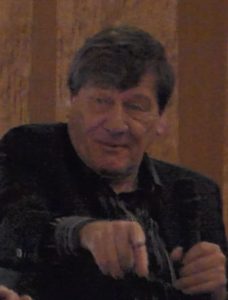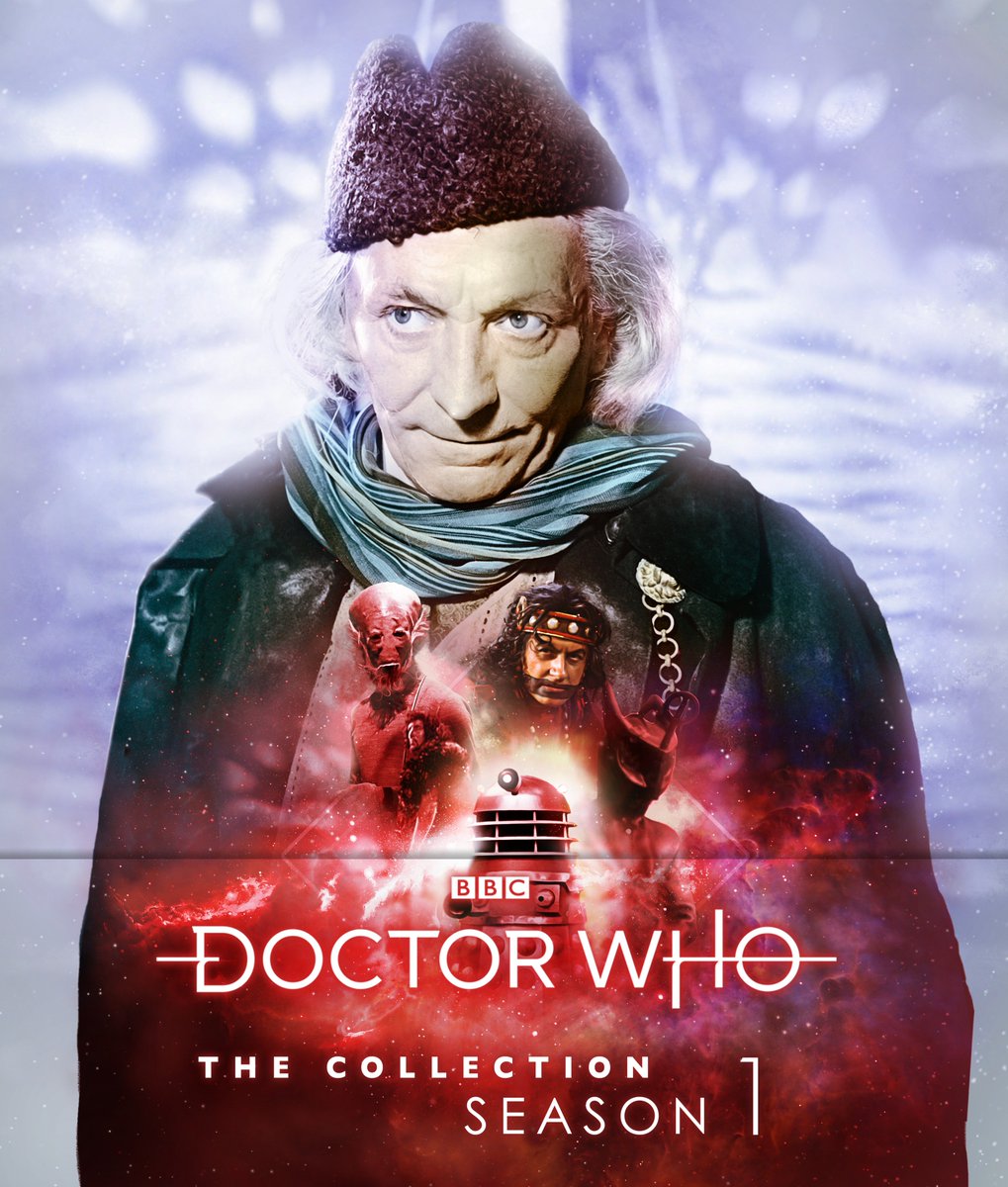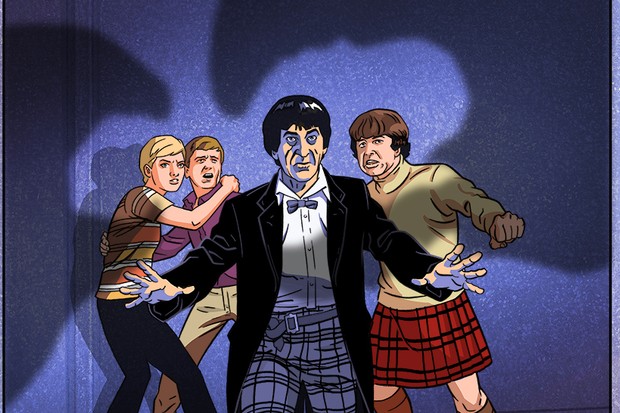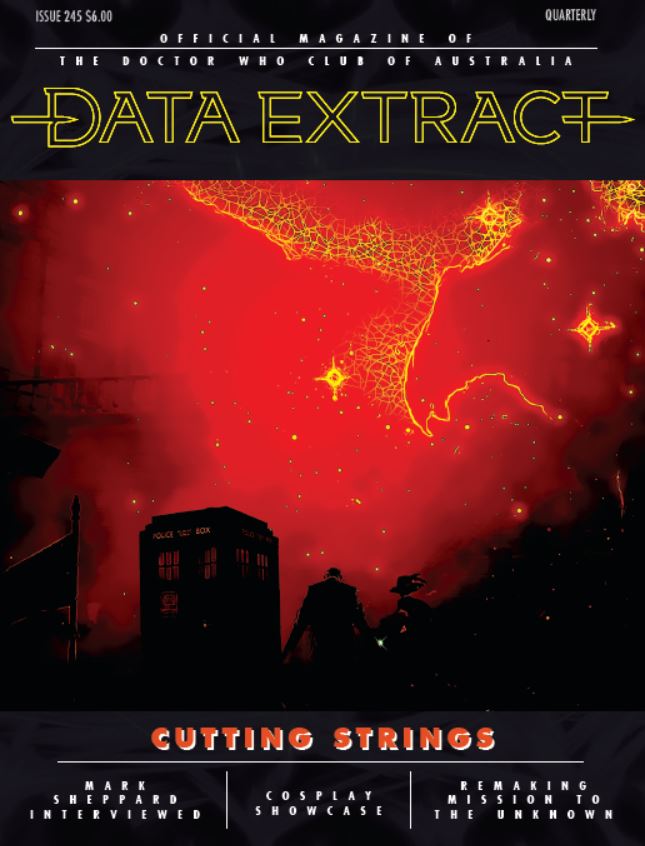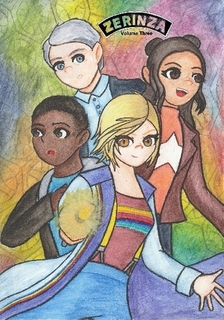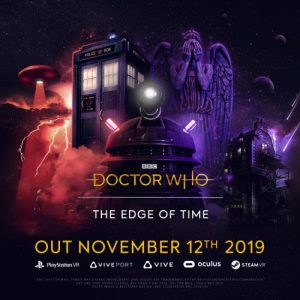The DWCA was very saddened to receive the news on 16 November that actor Ian Cullen had passed away at the age of 90. He was known and loved for appearing alongside William Hartnell in First Doctor story The Aztecs, as well as on audio with Eighth Doctor Paul McGann in Dark Eyes. He was also a special guest of the DWCA back in 2013 – a regular visitor to Australia when visiting his family here. By complete coincidence his last appearance in a Doctor Who related program was on the first episode of Australia’s own Whovians. As part of the program host Rove McManus was recorded running into a pub shouting “shark” to emulate Peter Capaldi’s performance when the Twelfth Doctor briefly visited Australia in The Pilot. He was as surprised as anyone when one of those in the pub turned out to be veteran Who actor Ian Cullen!
Actor, comedian and Whovians head researcher Patrick Magee recalled the moment himself when he was interviewed at a DWCA event, stating: “I remember my favourite part from the recording – it was such a surreal thing. In the very first episode, we had this idea that Rove would run into places yelling “Shark attack!” to see who would react. And we did it, and we ran into this pub, and this guy was like, “What are you filming for?”, and we told him it was a Doctor Who wrap-up show. He was like, “I was in Doctor Who”, and we were like, “No you weren’t, old man.” And then it turned out it was Ian Cullen from The Aztecs! It made no sense! Why was he in this pub at the exact moment we were filming this thing for Whovians? And he was wonderful.”
To commemorate Ian Cullen, his life and his contribution to our favourite show, we’ve reproduced here his interview with the DWCA that took place back in 2013, originally printed in Data Extract #221.

The Aztecs was just the sixth Doctor Who story to be made, so it would have seemed very much a new show that had no reputation behind it. How much were you aware of the programme before being cast in it?
Doctor Who was hardly on the radar of the professional theatre, ‘cos we were all theatre people. It was just a little children’s series which the BBC were doing, and the only people who watched it were children. The bigger actors thought it was a bit of a joke, and they wouldn’t have dreamt of going into Doctor Who. They were nervous about going into television at all. In those days, actors thought television was a step down; film actors thought their careers were over if they went into television. And we weren’t aware of Doctor Who. Doctor Who was happening in the studio as a bit of fun, but it was not considered to be important. Everybody thought it would run for six episodes and would disappear.
So how did the role of Ixta come along?
I was very lucky, because I’d been cast in a BBC television children’s series. I was playing David Balfour in Kidnapped and Catriona for 13 episodes. It was all on film, nothing in the studio, and the director of The Aztecs, John Crockett, happened to see some of it; he was watching the editing. He asked me if I’d like to play Ixta, and I said yes please! It wasn’t quite my first television role, but Kidnapped I don’t count because that was all on film. Doctor Who was my first chance to do a television play, and be in the studio for several episodes, so I grabbed it.
How have attitudes to TV changed since the ‘60s?
The big change is that back in the early ‘60s, almost everyone who was working in television had come from theatre. The writers, the directors, the actors, the costume people, the make-up people – they were all theatre people. We were accustomed to doing what we now call continuous recording, which means a show starts at the beginning and it goes through until the end, and it doesn’t stop. That’s the way it was, and that’s what people were good at. I think you’d find it difficult now to find a writer who could write a film script that could be filmed Scene #1 first and continuously record and go through ‘til the end. And almost impossible to find an actor who could learn it. Nowadays if an actor has to learn more than five lines, he gets into a panic.
Did working in theatre help you work in TV?
It certainly did help that we were theatre people, and we could therefore do continuous recording. But when you were working on television, you had to be infinitely more precise than you were in the theatre. Everything has to be in exactly the same place every time, so the camera sees it. You learn to be much more precise where you put the cup down, and with the timing, so when you pick up the cup, the camera goes with you to your mouth. When you go back into the theatre, that precision makes actors very charismatic. Instead of being a bit loose and relaxed about it, it taught us to be very precise, and that precision made theatre work much more interesting. Stage actors became much better as a consequence of working in television. It’s the opposite of what most people think.
A lot of effort went into creating some amazingly beautiful costumes and sets for The Aztecs, for something that we were only ever going to see in greyscale. Why was that?
That was precisely the reason – the colours had to be very clear, very bright, in order to get the greyscale, otherwise it just would have been black and white, and television would have been much less interesting. I still like black and white film; I love watching films and television programmes in black and white. But also, at that time, they were thinking ahead to colour television. They were very conscious of the fact that there were deep bright colours and sharp distinctions and definitions, and there were people during The Aztecs who were taking photographs and then going off and putting them on what we call a grey scale, in what was going to be a colour camera, to see what they looked like. They were working towards colour television and wondering whether it would have to be very different. In fact my wife was in the very first television play to be done in colour – a big epic called Hassan. It’s like watching a pantomime, because the colours are so bright, the costumes are so vivid. You can hardly watch it. The BBC had to learn to be more subtle with their lighting, and the colours for the costumes, when they went into colour.
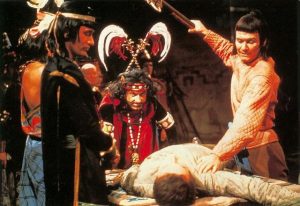
The scripting and the performances in The Aztecs make it particularly theatrical. Was that a conscious thing, or just a hangover of the theatre?
John Ringham’s performance was a conscious thing. John was a friend of mine until he died, and he always hated that performance. He was bitterly ashamed of it; he thought he’d gone far over the top. But there was a big difference between actors who’d done a lot of television, like William Hartnell and Bill Russell, and even I’d done Kidnapped; and actors who’d only done theatre. And the actors who’d only done theatre tended to give theatrical performances. It does stand out, but it’s brilliant. John Crockett could easily have said, “Tone it down a bit”, but he liked it.
Whereas Tlotoxl is an out-and-out villain, in many ways Ixta’s just doing what he thinks is right. How did you approach that?
You’re quite right – Ixta was right. Ixta was the good guy, because these people had come along and were intruding in his life. They were invaders, and that’s the only point of view to play it from. There might be someone there who’s so progressive as to say, “We must communicate with these aliens”, but Ixta wasn’t one of them. And that is always the approach – whatever part an actor’s playing, even if it’s an absolute villain, you have to do it from his point of view. In your own head, you’re doing the right thing. You might be doing very bad things that you know are bad things, but your reasons for doing them are good. The one exception is Richard III, who was John Ringham’s inspiration for Tlotoxl. Richard III enjoyed being a villain, wanted to be a villain. But that’s very rare.
In Episode Four you had your fight sequence with William Russell, who had already done a few daring adventures. Facing him with a balsa wood sword, how did you take on that sequence?
First of all, you take it on because you know you’ve got a balsa wood sword, so there’s not a really strong element of danger. Then there was the attitude of, “We mustn’t frighten the children”, so it didn’t have to be too realistic. Finally, we weren’t very good at it. We had to have some fairly rapid fighting-with-balsa-wood-sword lessons from the fight director, and then we went at it very gingerly. We kept breaking the swords, it was very difficult. He cheated; I should have won.

How much preparation time did you have on the day?
All of ten minutes. But we’re taught stage fighting at drama school, and we all know the basic moves. If you watch that fight, it is the basic “over the top, down to the side, parry, down the other side, parry, in the front, parry, parry, gotcha”. It’s half a dozen basic moves, and we repeated them.
And there’s no opportunity to make a mistake because of the way it was recorded back then.
This is one of the reasons why we were slightly careful. It wasn’t careful so much because we were frightened of hurting each other, but we were frightened of making a mistake and having to cause an edit, a retake, ‘cos that was serious business.
Were there any edits while you were shooting?
Not that I recall. There must have been, in a four-part serial. Editing was very expensive, and actors who constantly forgot their words, or fluffed their lines, didn’t work a lot, unless you were William Hartnell. But if you had technical mistakes, like a camera misses its shot, or a sound technician doesn’t get the boom there in time, they always edited those technical mistakes out first. And if they ran out of editing time, they kept the actors’ mistakes in. The punishment for making a mistake was that your mistake would be watched by millions of viewers. That’s all you could think about; knowing they were going to watch you fluff your lines. But actors like William Hartnell just got into the habit of letting it go. It became part of the fun. “There’s Bill forgetting his lines again.”
Even if mistakes did go out, you’d have the comfort that it wouldn’t be repeated. But now with repeats, DVD releases, books documenting every fluffed line, etc, those performances are put under a great deal more scrutiny. How nervous does that make an actor like you?
Some actors are more embarrassed than I am. I’m not embarrassed for it, but there are some actors who get quite distressed, because there used to be a rule that the BBC or the television companies couldn’t show a programme after 15 years without your permission, mainly because people don’t want their young selves to be on television when they’re trying to get work as a 67-year-old. That’s gone – they’ll show anything nowadays. I’m still haunted by lifting the concrete slab to block the secret passage in The Aztecs. We had to act lifting, ‘cos it only weighed about 2 ounces. I acted lifting so badly; if ever I watch it again I’m always constantly aware that I’m lifting that slab so very badly. Now at the end, I dropped off the top of the temple and splattered on the cobbles. In those days the cameras were huge, and there was no way they could swing one of those cameras up in the air and film me lying dead on the cobbles. So what they did was, they repainted the floor against the wall, so the cobbles were on the wall, and then I had to go onto the wall and pose. It looks very good! Those kinds of limitations forced creative solutions to problems; there was always an answer. That was the great thing. And the answer was never money. I don’t mean that as a joke, because the directors had to find a way of doing it. This is what you’ve got to do, it’s an impossible task, there’s no way we can do it – how do we do it? And they worked it out. Whereas now, the answer is, “It’s going to cost us a million dollars, we’ll do whatever we need to do. We can sink the Titanic, we can raise the Titanic”. So the answer now is basically money. You’ve got a problem, throw money at it; but in those days, you’ve got a problem, solve it.
Do you think that because you couldn’t rely on big budgets or CGI, there was more pressure to tell a good story, rather than just throw in some explosions?
That’s certainly right. There are so many films now which are virtually unwatchable. I can almost identify all the ones that I wouldn’t want to see because I know what’s going to happen. There’ll be a lot of explosions, a lot of car chases, at the end there’s going to be a very big building that blows up and the hero just escapes by jumping out a window. The pyrotechnics have more or less taken over the industry. It’s a great excuse for not being able to write well. I think the writing industry has suffered enormously, the theatre has suffered, because there aren’t many writers now who can write plays. I watched a play the other night that was 75 minutes, and my complaint when I came out was that it was too slow. What they had, basically, was a 25-minute play which they stretched out to 75 minutes. It’s very difficult to find writers who can actually write a play, and I think it’s disgraceful that we can’t find writers who can write films. They’re almost paint-by-numbers. The film industry’s in a sad place at the moment.
The Aztecs blew a lot of us away because it was such a strong script. It’s a shame the historical stories died out, because I can’t think of a historical Doctor Who story that’s actually bad.
It is a great shame that they didn’t want to go on with the historical ones, although the series would have ended. When I was young, one of my favourite writers was G.A. Henty, and he wrote a great series of books called I Went With Marco Polo, I Went With Francis Drake, and so on; about 40 or 50 of these books, with the whole of history laid out from the point of view of a young boy who somehow gets hooked up to the hero. I’ve just recorded I went with Francis Drake for an American radio company who are going to make all the Henty stories. I wish they were doing them on television, but it’d be very expensive. But the idea is still around, and hopefully these Henty stories might make radio popular again.
Speaking of radio, you hold the record for the longest gap between performances in Doctor Who – 48 years, from 1964 with The Aztecs until last year when you were in Dark Eyes for Big Finish, with Paul McGann as the Eighth Doctor. How did that come about?
Forty-eight years out of work! When I did The Aztecs, I honestly never thought I’d hear about it again. I never thought that my grandchildren would be watching it… and they don’t. It is a very exciting phenomenon. It is a great pleasure and a privilege to be here now, in Sydney, talking to Doctor Who fans. We do this quite often in the UK; I’ve done it once in America. It’s amazing to go around the world and find people who are linked by a common theme. And it’s not only a common universal theme; it’s always a very nice theme. The Doctor Who gatherings that I’ve been to, including this one, are very pleasant and happy occasions.
We’re lucky that The Aztecs is still with us, because so many episodes are missing. But some of your other work has been lost: the bulk of Emergency – Ward 10 and Z-Cars. It must be sort of galling that we have such a different attitude to television archives now.
With the benefit of hindsight, and the example of America, where they kept everything, right back to the first bit of film that was shot, it is astonishing that so many British programmes just disappeared. Back in the ‘60s, we couldn’t believe that the BBC and the other companies were not keeping programmes that they were recording. The argument was that nobody would ever want to watch it again; it’d be out of date, a police series like Z-Cars especially. The idea of Doctor Who, remember, is timeless. But police series, hospital dramas, they move on. Things change. When I was in Emergency – Ward 10, I was a brain surgeon, and I suggested to the producer that I should have my own little ambulance fitted up with equipment, so that when there was an emergency I could jump in my vehicle and perform a bit of surgery, with an operating theatre at the back. And she thought I was crazy! She said people would laugh at me. And that’s exactly what you’ve got now; paramedics buzzing around in their little ambulances. But I think the trick they miss is that for people to look back and say, “That’s the way it was” is always interesting. They’ve lost the idea of nostalgia being financially rewarding. It is a shame. But it’s also fun to think that the BBC, who wouldn’t pay the money to archive the episodes, are now spending a fortune trying to track these old episodes down, put them together and restore them. It’s ironic, really.
There was also an attitude that if you were repeating a show, you were putting actors and production staff out of work, because those were half hours where someone else wasn’t having to work to fill that slot.
I hadn’t actually thought of that. I remember, I was in a play called The Mousetrap in the West End; it was in its 17th year, and it’s now in its 61st year. I was virtually assaulted in the street by an actor who thought it was disgraceful that one silly little thriller should occupy a West End theatre for 17 years. He said you could have 50 plays on in that time. But I said to him, “Well actors are still working. It doesn’t matter whether it’s a new play every month; it’s still employing a different cast every year. Actors are still working, audiences are coming to see it, and that’s what the theatre’s there for.” But he was very upset, and I’ve never come across it, but I daresay people did feel that about television repeats. But I find it very odd to believe, unless you weren’t working in television, because if you were working in television you loved repeats. You got paid for them! One of my best friends has been an actor for 70 years, and he’s never been able to get near television. He can’t understand why, and that’s something we don’t understand; why some do and some don’t.
Some actors want to do television because it can become a good pension plan, and for a lot of Doctor Who actors, you’re still being paid for the work you did near 50 years ago.
My fee, when I did Doctor Who, was £60 an episode. I couldn’t give you precise figures, but I reckon I’ve made at least 5-10 times that every year from DVD sales, personal appearances and all that sort of stuff. It just goes on and on and on, and it’s been amazing. And for the guys who played Doctor Who, it must be a great pension plan! I wish somebody would ask me to play Doctor Who.
Eventually you got into long-term roles as a regular character, which must have been a bit of a change; going from bit-parts to having the next few years plotted out in front of you.
It was a great feeling to have a two-year contract. For an actor to be told that for the next two years, you know what you’re doing, it’s wonderful. Especially if it’s something interesting and exciting. I like fast-turnaround television; I’ve done a lot of it. In 1997, Family Affairs was starting. For the first time, they were trying to do a five- times-a-week soap, and everyone said it was absolutely impossible. EastEnders could only do three, Coronation Street could only do three, The Bill tried to do four and fell flat on its face. But the ace up the sleeve of the people who were running it was that they had Reg Grundy, who produced Neighbours. They imported all the knowledge that Grundy had accumulated doing five-times-a-week television in Australia, and they took his technique, the way he ran his show, they adopted it, and it worked like a charm. We were doing five-times-a-week television without any bother at all, it was the easiest job I’ve ever had, we were always home early, we always had weekends off, and to be quite honest we could have done eight. It was the happiest two years of my life, ‘cos there was no pressure, so it was great fun.

So where does life take you now?
I’m enjoying what is in many ways the most exciting time you could have. I’ve got a marvellous family, seven grandchildren; the youngest is just over four weeks old and that’s why I’m over here, to visit her. And also having a few jobs come along. Dragonslayer was great fun; Dawn of the Dragonslayer was an American film, made on a low budget, about fighting dragons. Marvellous part, I had; I got to stick a sword in my daughter. The same people have asked me to do another one. There’s also Drake; quite a lot of radio has come along. If I was asked to do some more five-times-a-week television, I would say yes. Or do another year of The Mousetrap.
What’s been your favourite medium?
Theatre’s my favourite. In television terms I would rather do fast- turnaround television than one play. If you do a play on television these days, you have to rehearse for weeks, and that would drive me nuts. I was at the Royal Shakespeare Company and we rehearsed King Lear for six months, and I only had two lines. Then we had to play it for six months. So that sort of work, I couldn’t face again. I do a lot of teaching; I teach Shakespeare. Look up Early Shakespeare if you’ve got children, because my wife and I do the voices for that. We’ve done Romeo & Juliet and A Midsummer Night’s Dream; we’re doing Macbeth next and then The Tempest. They’re great fun to do and they’re no stress. And that’s what I want at the moment – no stress so I’ve got time for my grandchildren.
Having worked with both William Hartnell and Paul McGann, how would you compare them?
It’s like trying to compare the prehistoric age with the future. It’s a totally different world, because actors are totally different. William Hartnell was actually a very important person; I don’t mean that Paul McGann is lesser, but the actual treatment, the attitude, and the way that people behaved, was just so different. I liked William Hartnell and I actually got on very well with him, we were friends for a long time, but if an actor behaved now the way that William Hartnell behaved, you’d think he was a joke. William Hartnell was very grand; he demanded a certain respect for his position and what he did and who he was, and he was very proud of his profession, and he was very aware that there were people who treated the profession lightly. He wanted people to be impressed by actors. He was like the actors of the late Victorian era, who were desperate for respectability. Whereas Paul McGann might walk in in jeans and a sweater, and say, “Mate, how are ya?” He wants to be treated as a sort of equal, thinking, “There’s nothing special about me, I’m just an actor”. That’s totally different to what William Hartnell was doing; he was saying, “I am an actor and I am special”.
What do you remember about your role in Blake’s 7?
Do you remember what I was saying earlier on about editing? That they wouldn’t pay for an edit? I got a telephone call quite late at night from a director who I’d worked with before. He said, “Ian, can you help us out? Can you come in tomorrow and do this long speech? The actor we’ve got can’t remember it, and so we’re going to have to edit”. So they sent a messenger round with this script, which I learned, and I went on and did it in one take perfectly. That’s how I got that job, and that’s all I remember about it. I turned up, I went in, I stood there, said it, and went home. So I don’t remember much about it. I knew Paul Darrow very well, we were in Emergency – Ward 10 together so he was a very old chum, but I didn’t meet any of the other cast. It was the most extraordinary experience. That was the reason for that; because an actor couldn’t learn his lines and the BBC wouldn’t pay for the edit. It was cheaper to get another actor; much cheaper than paying for a five-time edit. Roughly speaking, it cost £250 an edit and £60 for an actor. So if you’ve got an actor doing a speech and it needs five edits, forget it. Pay him off and get another one.
Was your accent in The Aztecs your choice or the director’s?
It was my choice. One of the traps of television and film is that you have to turn up with your performance worked out, and you do it. The director can tweak it, but if you turn up expecting the director to tell you what to do, you’ve had it. An awful lot of actors fall into that trap. With my performance, I kept saying, “Ee-an”, and if you listen to Dark Eyes, and this is completely accidental, but I’m doing exactly the same thing with a girl I called “Moll-ee”. It’s exactly the same trick, and I’d forgotten I’d done it in The Aztecs. It worked out well, it makes it interesting.
A lot of actors have rituals they go through, like a glass of champagne on the first performance. Have you come across any interesting rituals like that?
There are some extraordinary rituals. Jimmy Durante couldn’t perform if he saw a hat on a bed. He was doing a play on Broadway, and for a joke, one of his friends got into his flat and they put about 50 hats on the bed. And he didn’t perform, he couldn’t go on that night. He was absolutely terrified. James Stewart had a hat which he insisted on wearing in every film. If you look at any of his Western films, he’s always wearing the same hat. It was his lucky hat. He got into a great big argument with the director of The Man from Laramie, who said, “You can’t wear that hat, it’s not right”. So Jimmy said, “Well I’m not playing the part”. They had a great Hollywood standoff, with the contracted actor confronting the whole studio, and in the end the studio gave in and he wore his hat. I do a talk called The Curse of Macbeth, about superstition in the theatre and film world, and there are many very strange superstitions that actors have.
How do you think they would approach The Aztecs now, with modern technology and modern Who?
I think they’d spoil it by making it too complicated. They would be able to fly, and there’d be all sorts of explosions and battles, and there’d be superhuman beings and all the rest of it. There was something about The Aztecs; the feeling that they could come into your drawing room. There was something immediate about them, which made them believable and slightly frightening. And I think they’d lose that, probably; I can’t imagine them making something as simple as an Aztec.
Could you talk some more about William Hartnell?
We’re going back to the early days of television when everything was a bit experimental, and William Hartnell was carrying a great big load on his shoulders. He saw himself as leading this thing, and if it fell apart, it would be his fault. For that reason, he didn’t take fools gladly. Anybody who didn’t do their job properly got a kicking. He could be very irascible, but very often in television, there’s a lot to be irascible about, especially in the early days when the technicians, the directors, the producers, they were all trying things out. William Hartnell was learning a script a week, and with all the technical stuff he was trying to cope with, and the problems that he had to cope with, it’s amazing that he wasn’t more irascible than he was. I thought he was just totally professional and very much objected to anybody who wasn’t. I thought he was a great guy. I first met him when I was in a film with him; Sean Connery, Malcolm Lynch and William Hartnell were the three stars, and I had a tiny part. And on that he was quite irascible; I remember him being really cross with Sean Connery. He wasn’t easy by any means, but he was usually right. He had a lot of pressure on him, he was an elderly man thrown into a completely different world and coping with it magnificently, and I think a large part of the reason that Doctor Who is still with us is because of the footprint that William Hartnell laid down. He set the standard, saying, “This is not just a children’s series, we’re going to take it seriously as a drama. We’re going to do as well as we can possibly do”. He made everyone – including the joking BBC technicians who would rather be doing something more important – take it very seriously. And I think because he did that, it has longevity. So we owe him a great debt.
The costumes that you wore in The Aztecs were pretty outlandish. How is it wearing a cat’s face on your head?
To any actors out there, I suggest that you go and buy a mask and put it on, and see what happens to you, because it’s quite extraordinary. You put on a mask, and you take on the personality of the mask. You put a child in a tiger mask, and the child will become a tiger. So the moment that mask went on, Ixta become royal and terribly important. Before that he was less secure; he actually changes personality because suddenly he becomes The Man.
What was it like working with the companions?
The ethos in the theatre is that you get into a play, you meet for the first rehearsal, and the cast bond and become at least supportive of each other, if not great friends, for the rehearsal period and the run of the play. The moment the final curtain comes down, they never see each other again. But the feeling of friendship and family, when you’re working on a project together in the theatre, is very strong and real. In Doctor Who, the regular cast were the family, and they were looking after the rest of us. They protected us from William Hartnell! They were nice actors, nice people, they knew they were lucky to have that job, and they were thoroughly enjoying it. It was great fun to do with them; they were very happy and very pleasant. I’m still friends with Bill Russell and I’ve seen them at conventions since. They were lovely, very happy company. There was a certain feeling that Bill Hartnell was the King, and then there was the rest of us. We were all aware that we mustn’t upset Bill. We were warned, “Whatever you do, don’t forget your lines, ‘cos he’ll kill you”.
When your character in Z-Cars got killed off, it was a big shock. Were you involved in that decision?
A new producer came in, he rang me up at midnight, and he was drunk, and he said, “We’ve decided to kill you off”. It was a shock, and I was very upset. In those days it was a fairly new thing, but the pattern is now fairly set: if a soap is beginning to sag a bit, they kill somebody off, or they marry them off, or divorce them; they do something dramatic. I got short-strawed and I was killed. Good death though!
Would you ever work on the modern Doctor Who?
I would if I was asked. I’d do anything for money, dear!
